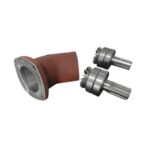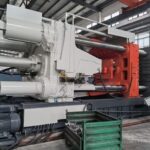Understanding Dental Bone Graft Materials
Dental bone grafting is a cornerstone of modern dentistry, enabling successful dental implant placement, bone regeneration, and various reconstructive procedures.
Here, we explore the key types of dental bone graft materials, their characteristics, and applications:

1. Autografts
- Harvested from the patient’s own body, providing high osteogenic potential.
- Common donor sites: mandibular symphysis or iliac crest.
- Advantage: Superior integration with host bone.
- Limitation: Limited availability and potential donor site morbidity.
2. Allografts
- Derived from human donors, processed to ensure biocompatibility.
- Available in various forms like particulate grafts and DBMs.
- Advantage: Reduced surgical time and easy availability.
- Limitation: Relies on host cells for regeneration.
3. Xenografts
- Sourced from animal bone (bovine or porcine).
- Porous structure supports bone ingrowth, gradually replaced by the patient’s bone.
- Advantage: High biocompatibility and availability.
- Limitation: Potential immune response.
4. Synthetic Grafts
- Includes ceramics (e.g., hydroxyapatite), polymers, and bioglass.
- Engineered for consistent quality and customizable properties.
- Advantage: Unlimited supply, eliminates disease transmission risks.
- Limitation: May have lower osteoconductivity compared to natural grafts.
Comparative Table: Bone Graft Materials for Dental Implants
| Material | Composition | Osteogenic Potential | Osteoconductivity | Biocompatibility | Cost |
|---|---|---|---|---|---|
| Autografts | Patient’s own bone | High | Excellent | Excellent | High |
| Allografts | Human donor bone | None | Good | High | Moderate |
| Xenografts | Animal bone (bovine) | None | Moderate | Moderate | Low |
| Synthetic Grafts | Ceramics, bioglass | None | Customizable | Excellent | Moderate |
Die-Cast Components in Dental Equipment
Die casting plays a significant role in manufacturing dental equipment components. While not directly related to grafting, aluminum die casting provides durable, precise components essential for dental practices:
- Dental Chair Frames: High-strength aluminum alloys like A356 ensure lightweight durability.
- Instrument Holders: Zinc alloys (e.g., Zamak 5) offer stability and precision.
- X-ray Machine Components: Magnesium alloys like AZ91D provide exceptional lightweight properties.
- Autoclave Chambers: Aluminum’s thermal conductivity ensures high performance under heat.
Searching for High-Quality for Cast Aluminum Parts?
You’ve come to the right place! Yongzhu Casting is a certified die casting manufacturer with over 20 years of expertise in the industry.
We have successfully completed numerous die casting projects for Aluminum casting parts, particularly in your industry.

Zhejiang Yongzhu Casting Technology Co., Ltd.
Location: Zhejiang, Shaoxing
Company type: Manufacturing
Year Founded: 2004
Main Products: Aluminium die casting, Mold Making, Die Casting, Sand Casting, Gravity Casting
Leading Chinese producer Yongzhu Casting is formerly known as Hangzhou Higer Metal Products Co., Ltd., was established in 2004.
With 20 years of experience in the industry, we are a specialized manufacturer in Aluminum casting and Machining.
Our products are widely used in various applications such as Automotive, Energy, Lighting, Medical, Home Furnishings, Machinery & Equipment etc. Below is one of our products.
It’s worth mentioning that the evolution of rapid logistics has transformed how industries approach purchasing. Aluminum casting orders can now be sourced from overseas suppliers efficiently.
For instance, working with YONGZHU CASTING, you can inquire, order, and even find better value than your local options—all while maintaining assured quality.
Design Review & DFM Support
Our professionals will evaluate your designs and provide suggestions for cost savings. Additionally, we offer Design for Manufacturing (DFM) assistance and conduct mold flow analyses to facilitate efficient production.
State-of-the-Art Manufacturing Equipment
Our facility is equipped with advanced hot-chamber and cold-chamber die casting machinery for aluminum and zinc production.
We also utilize high-precision CNC machines in a temperature-controlled workshop, featuring 3-Axis, 4-Axis and 5-Axis setups to manage any project you have.
Rigorous Quality Control Measures
Our dedicated quality control team ensures that all parts meet the highest standards of quality and consistency. We employ high-accuracy measurement instruments, including CMM, spectrometers, and X-ray detectors.
Comprehensive Surface Treatment Options
We provide a variety of surface finishing techniques for your precision die casting components. Our in-house services include cleaning, polishing, anodizing, shot blasting, and painting.
Flexible Project Acceptance
While larger manufacturers often shy away from low-volume projects, and smaller ones may struggle with quality, Yongzhu Casting stands apart. We prioritize customer satisfaction and willingly accept high-mix, low-volume projects like yours.

3 Healing Stages of Dental Bone Grafting
Healing after dental bone grafting involves three main stages:
1. Inflammation (0-3 days)
Swelling, tenderness, and potential bruising occur. Ice packs and rest are essential during this phase.
2. Repair (3-6 weeks)
Bone cells form around the graft material. A soft diet and meticulous oral hygiene support this stage.
3. Remodeling (3-9 months)
New bone matures and integrates with natural bone, solidifying the foundation for dental implants.
Strategies to Speed Up Healing
| Tip | Explanation | Benefit |
|---|---|---|
| Follow Post-Surgical Care | Adhere to dentist’s guidance. | Reduces infection risks. |
| Maintain Oral Hygiene | Use a soft-bristled toothbrush and rinse. | Prevents infections and promotes health. |
| Rest and Elevate | Sleep with your head elevated. | Reduces swelling and enhances healing. |
| Quit Smoking | Avoid smoking during recovery. | Improves oxygen flow for regeneration. |
FAQs
- What is a dental bone graft?
A dental bone graft is a procedure where bone material is used to replace or repair damaged or lost bone in the jaw. This supports the placement of dental implants and promotes bone regeneration. - What materials are used in dental bone grafts?
Common materials include autografts (patient’s own bone), allografts (donor bone), xenografts (animal bone), and synthetic grafts like hydroxyapatite and bioglass. - Which bone graft material is best for dental implants?
The choice depends on factors like the size of the bone defect, the patient’s health, and surgical considerations. Autografts offer the best osteogenic potential, but allografts and synthetic materials are also commonly used. - How long does the bone graft healing process take?
Healing typically occurs in stages, with initial healing taking 3-6 weeks, followed by remodeling, which can take 3-9 months. - Are there any risks associated with dental bone grafting?
Risks include infection, graft rejection, and complications related to the donor site in autograft procedures. - Can synthetic bone grafts be used for dental implants?
Yes, synthetic bone grafts such as hydroxyapatite and bioglass are commonly used in dental implants. They are biocompatible and eliminate concerns about disease transmission. - Do bone grafts require any special care after surgery?
Yes, it is essential to follow post-surgical care instructions, maintain oral hygiene, and avoid smoking to ensure proper healing and avoid complications. - How does the bone graft integrate with the surrounding bone?
The graft material provides a scaffold for the new bone to grow into, promoting the formation of new bone cells that eventually integrate with the existing bone. - What are the advantages of using autografts for bone grafting?
Autografts are considered the gold standard for bone grafting as they contain living cells that promote bone formation. They also avoid the risk of disease transmission. - Can dental equipment be made with die-cast aluminum?
Yes, many dental equipment components like chair bases, instrument holders, and X-ray machine parts are made from aluminum alloys using the die-casting process. This ensures durability and precision.
Conclusion
Dental bone grafting is pivotal in modern dentistry, enabling enhanced outcomes for dental implants and reconstructions.
Aluminum die casting complements this field by providing durable components for essential dental equipment.
For reliable aluminum die-casting solutions tailored to your dental equipment needs, contact Yongzhu Casting today!

















